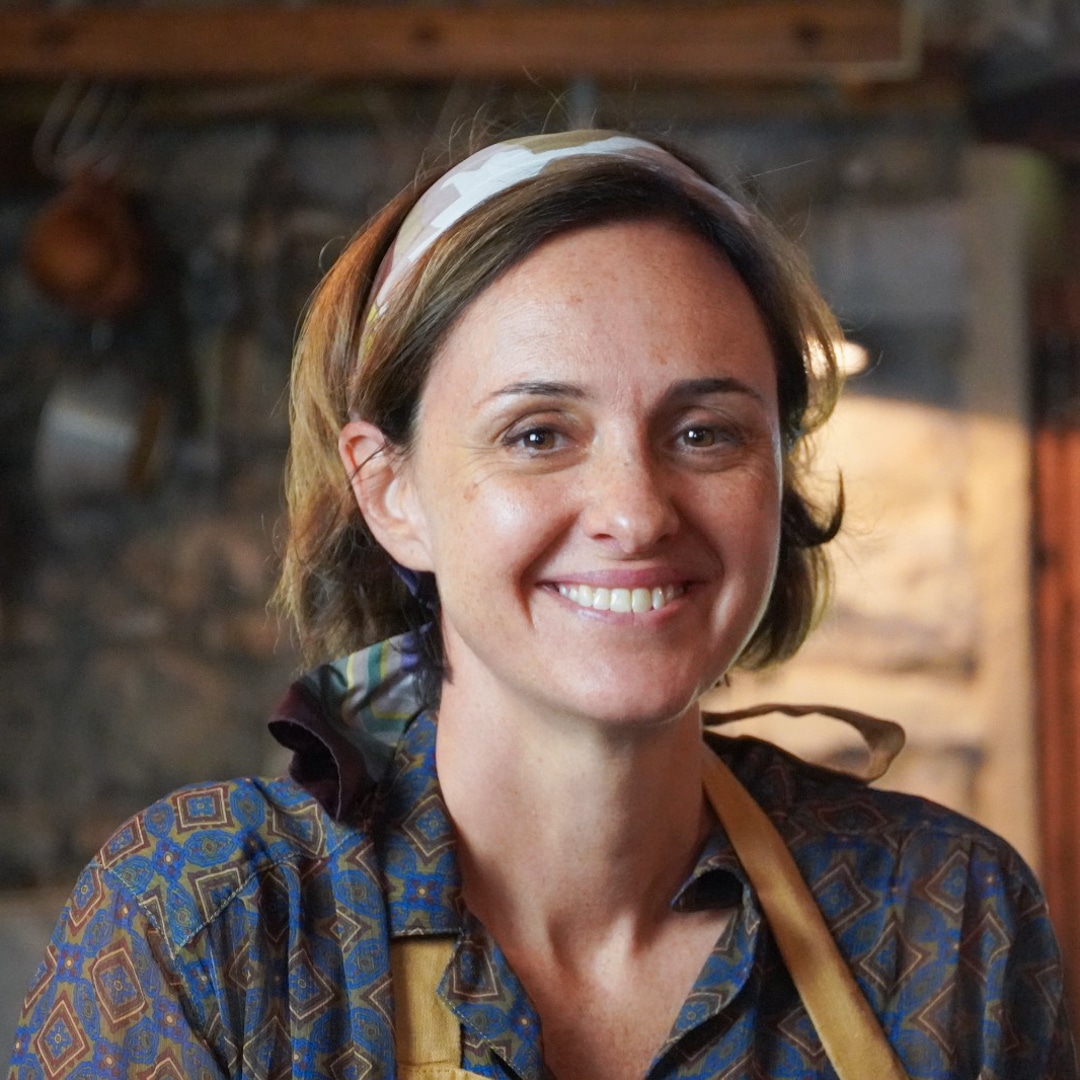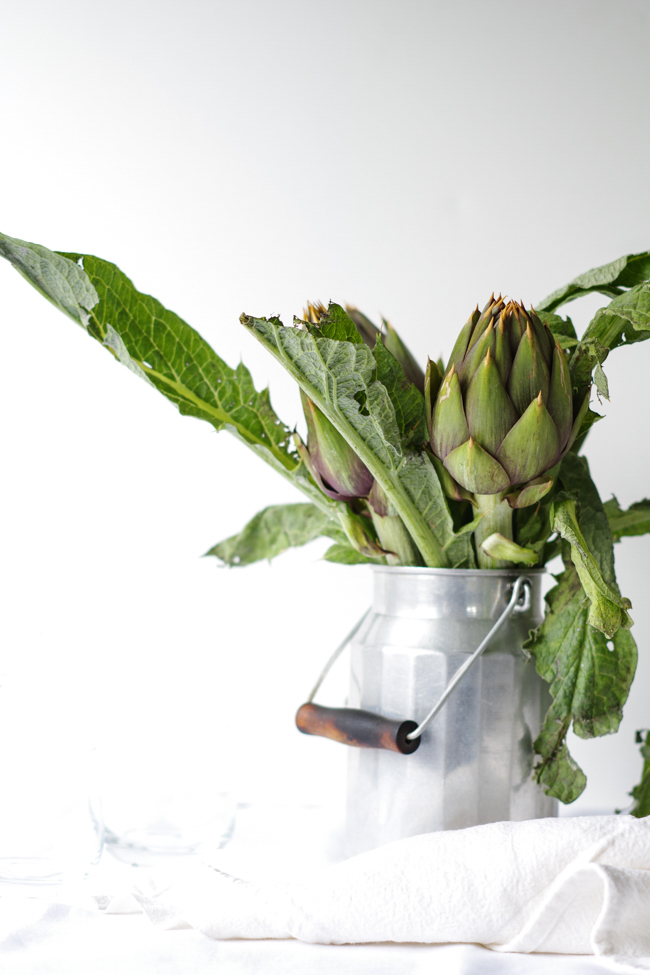

What to do when a huge box of fresh, flavoured, thorny artichokes– a present of your trusted farmer – stand mocking on the table of your kitchen? You watch it, you try to ignore it, than you watch it again and eventually you give up. That’s how it goes. You arm yourself with a knife, a big bowl full of water, a couple of lemons and a great deal of patience. And you start cleaning, cleaning, cleaning and again cleaning artichokes.
Then – provided that in the meantime the sun hasn’t set – with your hands aching for the scratches and the tips of your fingers darkened by the chlorophyll, you eventually have fun and start preparing the Italian Riviera artichoke pie, one of the best ever springy pie and deserved reward for the hard work done!
This is what I actually learned a couple of days ago after an afternoon spent cleaning artichokes, and here below you can find the traditional recipe of the artichoke pie I used and which is reported in all the ancient regional cook books.
Before that, however, I wish to make a quick jump in Genoese cuisine history with regards to vegetable pies and then to give you some tips to make the artichoke pie as a real Genoese cook (feel free to go directly to the recipe, I know I’m a bit wordy this time).
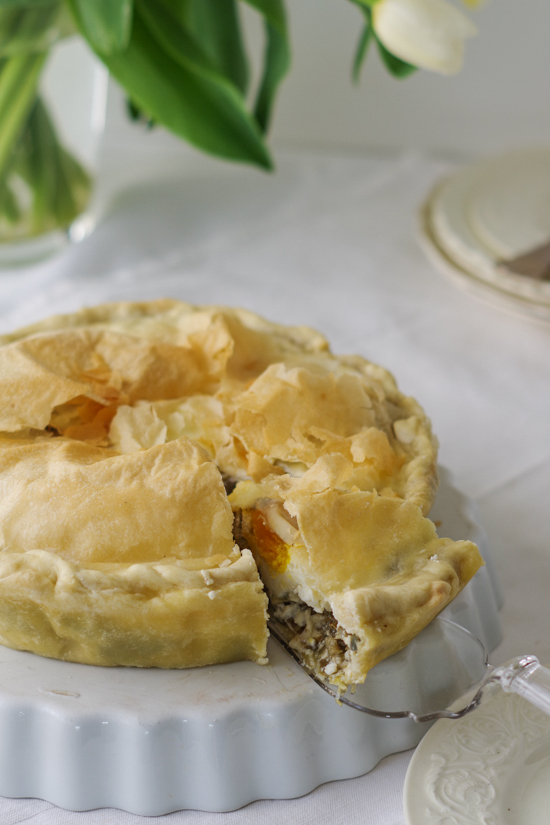

Some history of the Genoa cuisine and of its vegetable pies
You should know that Genoa and the Italian Riviera are famous for their vegetable pies, of very ancient origin actually. Indeed, at the beginning of the middle ages in Genoa – a powerful Mariner Republic – many extremely rich merchants, bankers, brokers and insurers lived. This people could afford tangible luxuries and very refined consumptions.
Their high standard of welfare reflected directly in the kitchens and on these patrician-merchants’ tables skilled cooks used to serve more and more sophisticated dishes.They worked, modified and cleverly combined the raw materials (never lacking in Genoa where the port docks overflew of goods).
Whilst in the middle Europe and in the countryside castles the nobles showed off their power and prosperity serving on their tables at most roasted meats, Genoese were perfecting the arts of pasta making, of filled pasta and pies, of sauces and of the use of spices and aromatic herbs.
The patrician cooks, in particular, learned to prepare dishes wisely combining the ingredients at their disposal e.g. fresh cheeses (coming from the backcountry valleys or from Sardinia) vegetables (from the vegetable gardens farmed in the valleys behind the port area) spices (coming from the trade with the Middle East) and nuts (pine nuts, walnuts almonds: their use was learned in the East and on the Black Sea). Furthermore, a warm weather did not require a huge number of calories intake and the merchant profession did not imply particular physical efforts. All these factors brought to the development in Genoa of a very light diet, mainly based on pasta and vegetables, sophisticated and of very high nutritional quality. In other words, the precursor of the well-known Mediterranean diet.
And in this context vegetal pies appeared on the tables: shells made of multiple layers of puff pastry, filled with seasonal vegetables (chards, wild herbs – such as the famous prebuggiun – artichokes, pumpkin), fresh cheese, eggs, aromatic herbs and spices. The Genoese artichokes pies, in particular, was a very refined dish usually served at Easter on closing of the artichokes’ season.
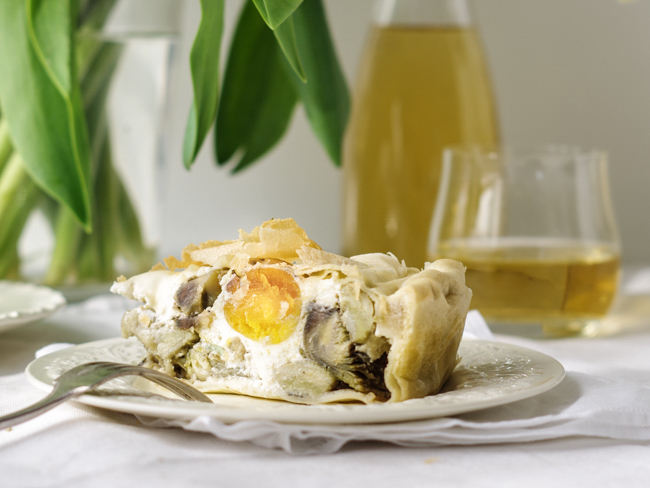
Some tips and tricks for preparing the Italian Riviera artichoke pie
- The ultimate cheese for making Genoese vegetable pies is prescinsêua, a renneted cheese typical of Genoa backcountry. In the city of Genoa this cheese is easy to find in the supermarket sold in . Outside Genoa, on the other hand, it is quite rare, as it doesn’t have a long life span, so it can’t really be shipped far from where it is made. However, in making vegetables pie you can substituted this cheese with ricotta, as Genoese housewives actually do from time to time (but in this case omit to add the flour provided for in the recipe). Or if you wish to keep the sour taste of prescinsêua the perfect substitution, according to my experience, is 2/3 of ricotta cheese and 1/3 of sour cream or Greek yogurt.
- Be sure to make very thin sheets of pasta, this is the challenge of the recipe! To obtain a very elastic dough it is very important to work it hard and for a long time at the beginning and then to leave it rest for a while to let the fibres soften. Dust very well with flour the working surface and the dough as well when you roll and stretch it.
- have fun and try to inflate the pie: leave a small hole in the dough before sealing the filling, blow through it under the last sheet of dough and quickly seal it. During cooking the dough will harden and crack and maybe will crush. It doesn’t matter! The pies will look delicious and very handmade and the thin crumbs are so good!


The traditional recipe of the Italian Riviera artichoke pie
Ingredients
For the dough
- 250 g (2 cups) of all-purpose flour, unsifted
- 120 ml (3,3 fl oz) of water, room temperature
- 2 tablespoons of extra
For the filling
- 1 small onion, sliced
- 6 artichokes
- ½ lemon
- 4 tablespoons of extra virgin olive oil, plus extra to grease
- 3 tablespoons of parmesan cheese
- 1 tablespoon of marjoram leaves (or parsley), minced
- 150 g (5,3 oz) of ricotta cheese
- 100 g (3,5 oz) of sour cream
- 1 tablespoon of all-purpose flour
- 30 g (1 oz) of unsalted butter
- 4 eggs
- Salt, t.t.
- Pepper, t.t.
Instructions
For the dough
- Put the flour in a bowl, add 80% of the water and two tablespoons of extra virgin olive oil and start kneading.
- If necessary, add some more water from time to time until the dough is firm and homogeneous.
- Take the dough off the bowl and continue kneading with the lower part of your palm on a surface well dusted with flour for 5/10 minutes. The dough will become more and more elastic this way.
- Divide the dough in 6 small balls of the same size, cover with a cooking film or with a humid cloth and leave in the fridge for at least 1 hour.
For the filling
- Clean the artichokes removing the external harder leaves, remove the thorns and the internal tassel. Cut them in slices and put them in a bowl full of cold water where you have previously squeezed a lemon (this will prevent the artichokes to oxidise and darken meanwhile you finish cleaning and cutting the others).
- Brown the onion in a big skillet with 4 tablespoons of extra-virgin olive oil.
- When pale gold add the artichokes cook at low heat, stirring from time to time, for about 10 minutes, or until the artichokes are tender.
- Remove from the fire, put the artichokes in a bowl and add the parmesan cheese and the marjoram leaves. Stir, taste and season with salt and pepper.
- Aside, in another bowl, water down a tablespoon of flour in the sour cream and then add the ricotta cheese. Combine well and season with salt.
For the pie
- Preheat the oven at 200°C (425 F).
- Grease a cake tin of 22/24 cm (ab 9 in) with olive oil. Take one of the dough balls from the fridge (leave the other in the fridge) and roll it with a rolling pin on a surface well dusted with flour.
- Roll until 1 mm (0,04 inches) thick. You can use your hands to stretch the dough: when you have rolled it in a thin disk put it on the back of your hand and with the other gently stretch the borders in all directions.
- You shall obtain a disc wide enough to cover the cake tin and get out of the edges for a couple of centimetres (ab 1 inch). Don’t save flour! Use as much as you need to avoid that the dough sticks to your hands or to the surface.
- Cover the cake tin with the rolled dough and grease the surface of the dough with a very thin film of olive oil. Repeat the same operation with other two dough balls remembering to grease with oil the surface of the rolled dough each time.
- Once the three layers base of the pie is finished it is time to put the filling inside. First pour the artichokes and gently flatten with the back of a spoon. Then pour the ricotta cream and level it off.
- With the help of a spoon make 4 equidistant holes in the filling as big as an egg. Put a flake of butter in each hole and then open an egg in each hole. Dust each egg with some salt and pepper.
- Cover the pie with three other layers of dough finely rolled and greased with oil as above.
- Once the cover is completed, cut the dough in excess from the borders of the tin and roll the edges inside to seal the filling being careful not to leave holes.
- If you wish you can have fun and try to inflate the pie: leave a small hole in the dough before sealing, blow through it under the last layer of dough and quickly seal it.
- Cook in the oven at 200°C (425 GF) for about 45 minutes or until the dough is gold and crispy.
- Serve at room temperature. The day after is even better!
And here is a step-by-step guide !












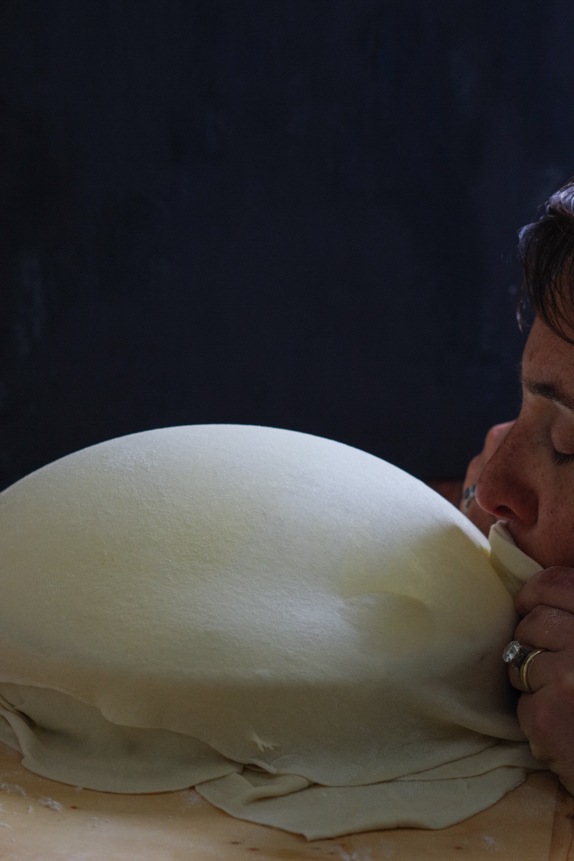

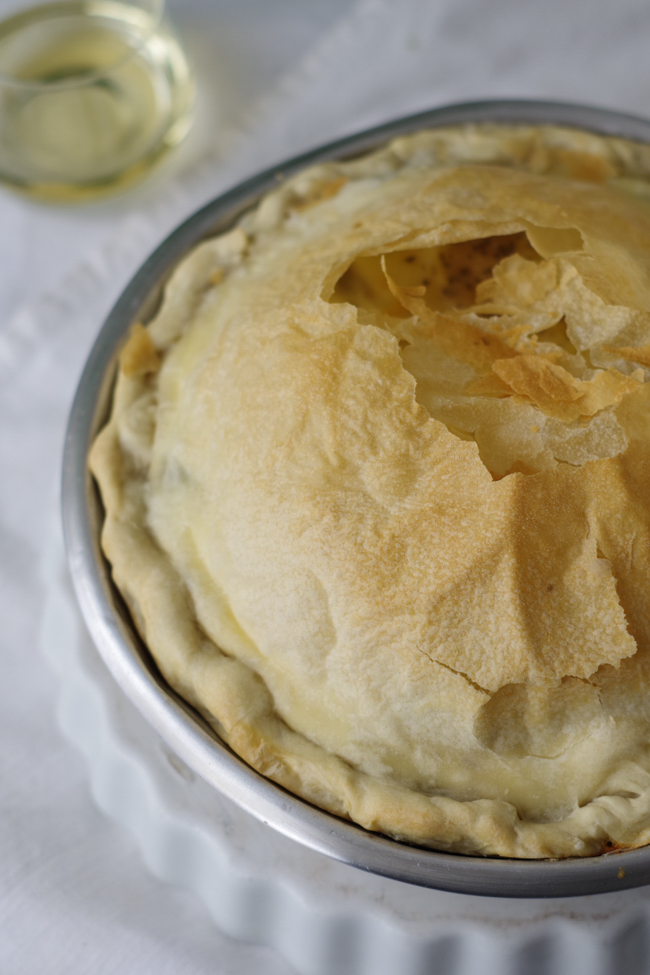


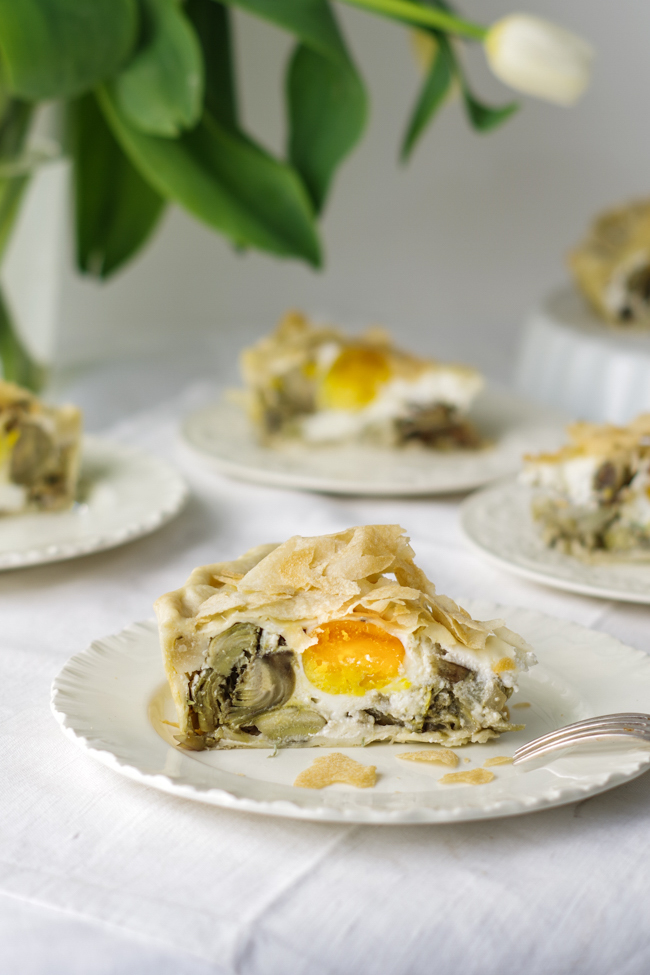

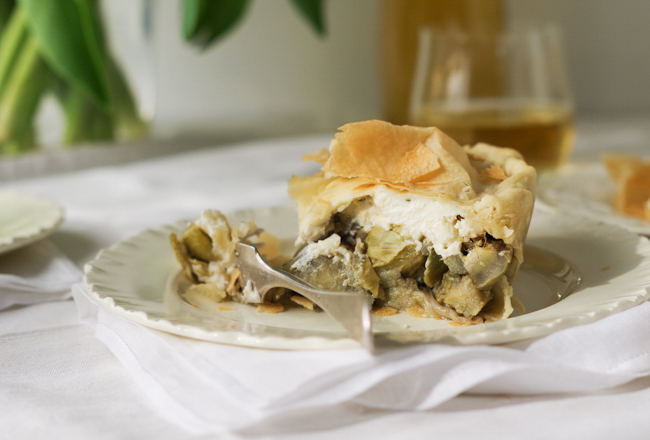
JOIN ME ON MY FOOD JOURNEY
Get my monthly newsletter with fresh recipes, my latest food adventures, upcoming events, and lots more from the sunny Italian Riviera!
SHARING IS CARING!
If you liked this post, please share it with your friends!!


